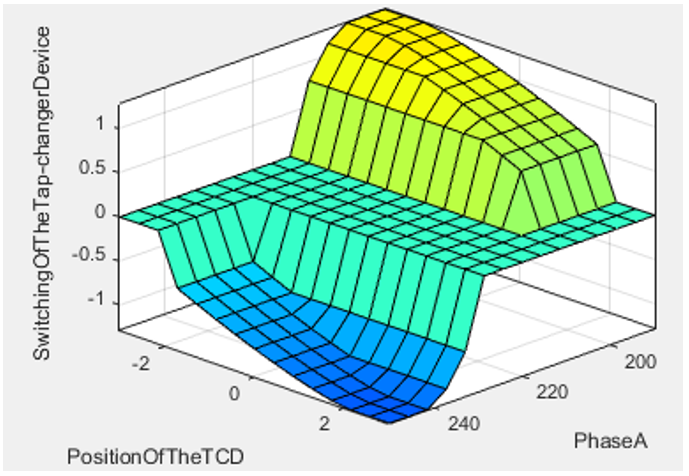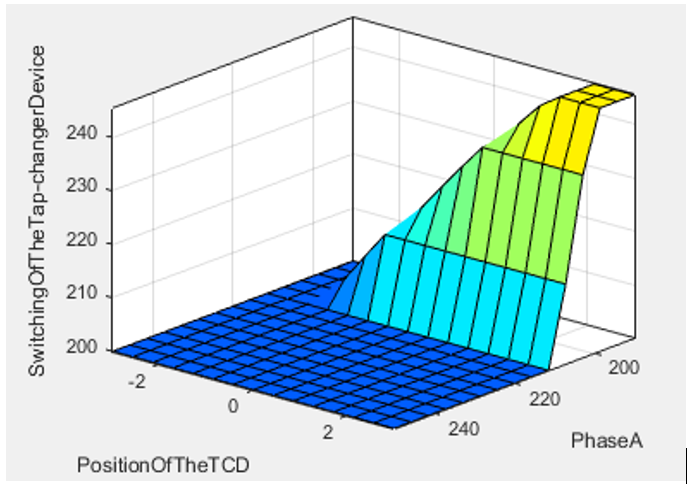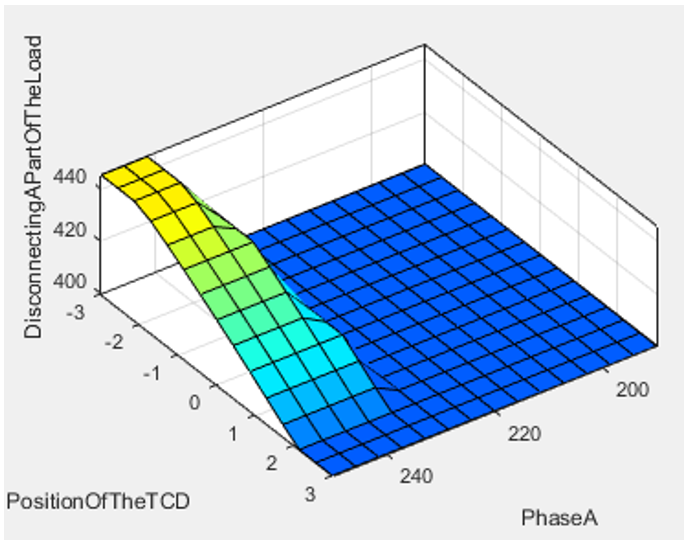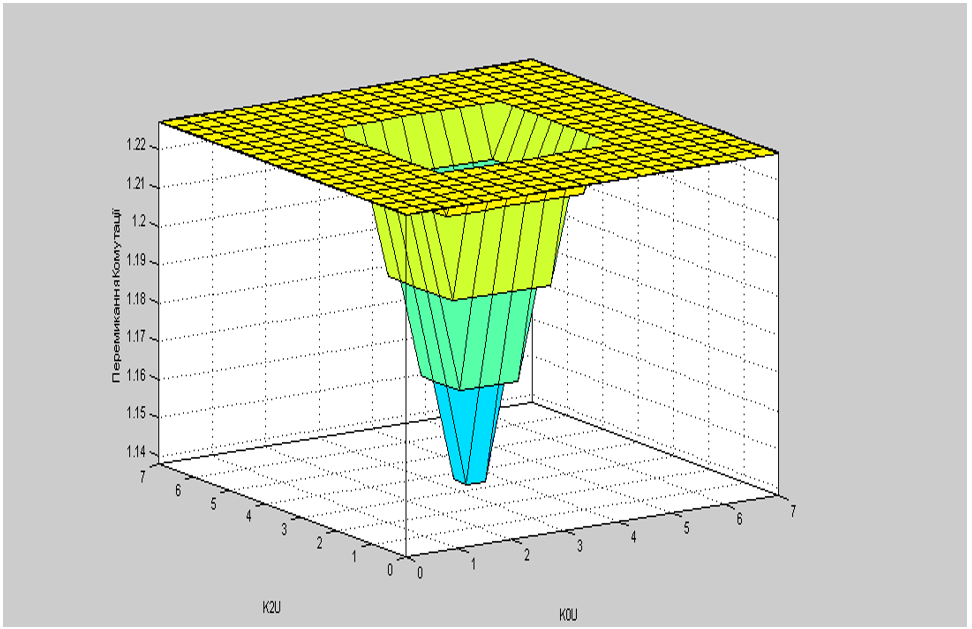Method of regulating power quality indicators
Anton Panov
State Biotechnological University, Kharkiv
Introduction
One of the important requirements for electricity supply is ensuring the quality of electricity, which is understood as the degree of compliance of quality indicators with accepted standards. Deviation of voltage and other quality indicators from established norms significantly affects the operation of electrified equipment and electrical networks, which leads to electromagnetic and technological components of economic damage. Also, voltage asymmetry is one of the urgent problems of 0.4 kV three-phase electrical networks. The asymmetry of the voltage is manifested in the inequality between the models of the phase voltage vectors and the shift angles between them.
IEEE Std 1100-2005. IEEE Recommended Practice for Powering and Grounding Electronic Equipment [1] (hereinafter IEEE) and DSTU EN 50160:2014 “Characteristics of power supply voltage in electrical networks of general purpose” (hereinafter DSTU) [2] establish indicators and norms of power quality in electrical networks of power supply systems general purpose alternating three-phase and single-phase current with a frequency of 50 Hz at the points to which electric networks owned by different consumers of electric energy or receivers of electric energy (points of general connection) are connected.
The power quality standards established by the standard are electromagnetic compatibility levels for conductive electromagnetic disturbances in general purpose power supply systems. In compliance with established standards of electricity quality, electromagnetic compatibility of electrical networks of energy supply organizations and electrical networks of electricity consumers is ensured.
The standard does not establish requirements for the quality of electricity in special-purpose electrical networks (contact, traction, communication), mobile installations (planes, trains, ships), etc. The standard does not establish power quality standards for regimes caused by force majeure (exceptional weather conditions, natural disasters, etc.).
DSTU EN 50160:2014 is the first standard in the field of electricity quality, which states that the established norms are subject to inclusion in the technical conditions for the connection of consumers and in energy supply contracts.
The standard regulates voltage deviations at the terminals of electrical energy receivers. The normally permissible and maximum permissible values of the established voltage deviation are respectively equal to ± 5 and ± 10% of the nominal value of the voltage and at the points of common connection of consumers of electric energy must be established in energy supply contracts for the hours of minimum and maximum loads in the power system, taking into account the need to comply with the norms of the standard on conclusions of receivers of electrical energy in accordance with regulatory documents.
Consumers of electrical energy work most efficiently at nominal voltage. However, it is practically impossible to provide nominal voltage to all consumers. Each conductor has a certain resistance, so the passage of electric current through the electrical network is associated with voltage losses. These losses do not remain unchanged, since the network load constantly changes during the day, season, year, etc. [3].
As a result of the load change, the voltage loss in the network also changes, and as a result, the voltage at the terminals of consumers changes [4]. These changes can be fast and short-term (for example, during the start-up of an asynchronous motor with a short-circuited rotor) or slow and long-lasting (with a gradual change in load over the course of a day or year and with smooth voltage regulation) [5].
Voltage asymmetry is one of the indicators by which the quality of electrical energy is assessed in three-phase electrical networks with a voltage of 0.4 – 10 kV in accordance with DSTU EN 50160:2014. According to these standards, the voltage asymmetry coefficient leads to a sharp decrease in the efficiency of three-phase asynchronous motors, despite the fact that most of the industry works only on asynchronous motors. Therefore, voltage asymmetry should be carefully studied and controlled.
In the lighting network, voltage deviations occur:
– change of light intensity;
– shortening the service life of incandescent lamps;
– increase in consumption power.
Relatively small voltage changes have little effect on the luminous flux of the lamp. With large voltage drops, the lamps either do not light up or blink, which sharply shortens their service life.
The lighting of workplaces significantly affects labor productivity. According to available data, a decrease in illumination by 1.5-2 times reduces labor productivity by 1-2%. In addition, illumination has an effect on vision, which deteriorates sharply with reduced illumination. (Considering that the illumination depends on the voltage, it has rather strict requirements, specified above).
If we take into account that when the voltage is reduced by 5%, the luminous flux of incandescent lamps decreases by 20%, then the systematic reduction of voltage during the hours of maximum loads is accompanied by the replacement of incandescent lamps with more powerful ones. After the normalization of the situation, consumers do not immediately return to the former lamps, which causes increased electricity consumption for a long time. The operation of fluorescent lamps depends less on voltage deviations. Their service life changes by 4% with a voltage deviation equal to 1%.
The most common sources of voltage asymmetry in three-phase power supply systems are those consumers of electricity whose symmetrical multiphase implementation is either impossible or impractical for technical and economic reasons. Such installations include induction and arc electric furnaces, traction loads of railways, made on alternating current, electric welding units, special single-phase loads, lighting installations [6].
Asymmetric voltage regimes in electrical networks also occur in emergency situations – when a phase is broken or asymmetric short circuits [7].
Voltage asymmetry is characterized by the presence in a three-phase electrical network of reverse or zero-sequence voltages, which are significantly smaller in magnitude than the corresponding components of the forward (main) sequence voltage [8].
The asymmetry of the three-phase system of voltages arises as a result of superimposing the reverse sequence voltages on the direct sequence system, which leads to changes in the absolute values of the phase and interphase voltages.
Purpose and tasks
The purpose of the work is to develop a model that regulates the quality of electrical energy, namely such indicators of electricity as the steady voltage deviation and voltage asymmetry coefficients in reverse and zero sequence.
To build a model of regulation of the quality of electrical energy, it is necessary to perform the following tasks: develop a block diagram of the algorithm for regulation of the established voltage deviation; to develop a block diagram of the algorithm for regulating the voltage asymmetry coefficient by reverse and zero sequence in electrical networks.
Materials and methods
Based on the analysis and development of the method of regulating the quality of electrical energy due to the control algorithm based on fuzzy logic, presented in the article [9], it is better to estimate the harmonic components of the voltage using the modernized method of correlation functions.
As a basis for the new algorithm, a section of mathematics was used, which is a generalization of classical logic and set theory [10], based on the concept of fuzzy sets, introduced as an object with the function of element belonging to sets that apply any values in the interval [0;1].
This ensures high accuracy of the estimation of harmonic voltage components.
To develop a fuzzy algorithm for regulating the steady voltage deviation, fuzzy variables were taken as the input parameters of the fuzzy output system, i. e. responsible for the phase voltage and the on-load control drive device itself: “Phase A”, “Phase B”, “Phase C” and “Position of the tap-changer device”. Also, the initial parameters of the system were vague variables, such as: “Switching of the tap-changer device”, “Disconnecting a part of the load” and “Inclusion of an additional load”.
The following term sets were written for fuzzy variables:
Tu = {“UAlow”, “UAmid”, “UAhigh”};
Tu = {“UBlow”, “UBmid”, “UBhigh”};
Tu = {“UClow”, “UCmid”, “UChigh”}.
The membership functions of the terms of sets Tu are chosen in accordance with the norms of the standard and look as follows:
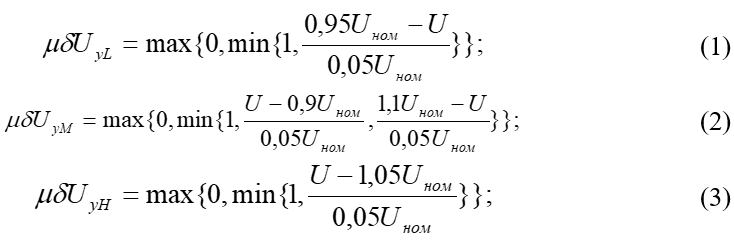
This is a function of belonging to established deviation indicators, which describe low, medium and high degrees of deviation from the requirements of norms and standards.
As term sets for the fuzzy variable “Position of the tap-changer device” were written:
Tp = {“TAPmin”, “TAPmax”}.
To write term-sets for a fuzzy output variable for indicators such as “Switching of the tap-changer device”, “Partial load disconnection” and “Additional load inclusion” look as follows:
Tn = {“TAP-“, “TAP+”};
To = {“OFF load”};
Tv = {“ON load”}.
The coefficients of voltage asymmetry on the reverse and zero sequence “K2U” and “K0U” are presented in a fuzzy form, as it is proposed in [11-13], and the output parameter is a fuzzy variable: “Inclusion of the switching device”, as presented in [14-18].
The sets Tk={“K2Un”,”K2Uh”} are used as set terms for the fuzzy variable “Coefficient of voltage asymmetry in reverse sequence”.
Likewise, the set Tk={“K0Un”,”K0Uh”} is used as the term set for the fuzzy variable “Strength asymmetry coefficient at zero sequence”.
The membership function of the term sets Tk are chosen in accordance with the norms of the standards and have the following form:
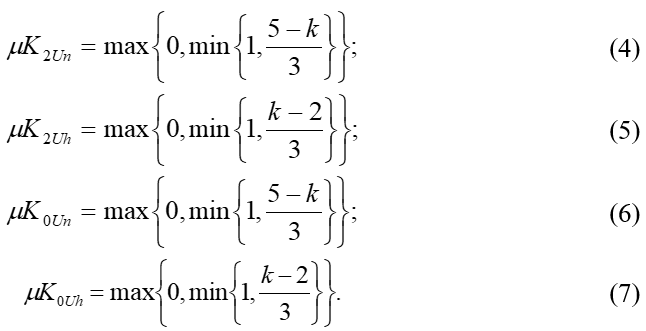
At the same time, each of the terms of the first two variables is evaluated on the scale of the asymmetry coefficient from 0% to 5%.
The set To = {“PC”} is used for the “Toggle” fuzzy output variable.
Results
After setting the rules of fuzzy output in the “Fuzzy Logic Toolbox” toolkit in the MATLAB package, we will get the result for the output variable of the “Switching tap-changer device” indicator at specific values of the input variables, presented in the view of the graphical interface in Figure 1.
In the same way, a graphical interface is built after obtaining the results for the output variable of the “Partial load disconnection” indicator at other values of the input variable of one of the three phases, which is presented in Figure 2.
Similarly, a graphic interface is built for the output variable of the “Inclusion of additional load” indicator (Fig. 3).
Figure 1 – Fuzzy Output Surface View UI Graph for “Twitching Tap Device”
Figure 2 – Fuzzy Output Surface Viewing Interface Graph for “Partial Load Cutoff”
Figure 3 – Fuzzy output surface viewing interface graph for “Additional Load Inclusion”
The graphic interface for viewing the surface of the fuzzy output shows that when the voltage on one of the three phases changes, the on-load tap-changer device will switch to the desired position. When the voltage on two phases changes, an additional load will be switched on or a part of the load will be switched off.
The graphic interface for viewing the surface of the fuzzy output (Fig. 4) shows that when the voltage asymmetry coefficient changes in reverse and zero sequence, commutation will occur. Asymmetry in the reverse, as well as in the zero sequence, is solved in the same way, that is, with the help of a transformer substation, which is equipped with a tap-changer device, which is able to change the commutation of the consumer to the phases, that is, by switching the commutation of consumers between phases.
Figure 4 – Fuzzy Output Surface View GUI for “Toggle Switching”
Conclusions
The existing methods of regulating the quality of electrical energy are analyzed. The shortcomings and problems of the issue related to the improvement of the quality of electricity were revealed.
The scientific novelty of the work consists in the improvement of the model of regulation of electric energy quality indicators based on the method of fuzzy logic.
The practical value of the work is as follows:
– the built model using the method of fuzzy logic allows to speed up the coordination of the transformer with tap-changer with the control scheme and to establish more accurate voltage regulation, which will increase the efficiency of the transformer and the system itself;
– the results of the work can be used in the design of the substation for introduction into the power system.
Further research by the authors may be directed to the development of control schemes for transformers with on-load tap-changer and the creation of FPGA models for the implementation of more detailed integer calculations.
References
- IEEE Working Group on Power System Harmonics, “Power system harmonics: an overview”. IEEE Trans. Power App. Syst. 1983. Vol. PAS-102, no. 8. P. 2455–2460.
- DSTU EN 50160:2014 “Characteristics of power supply voltage in general-purpose electrical networks.” – Instead of DSTU EN 20160:2010; Input 05/20/2014. – Kyiv: Ministry of Economic Development of Ukraine, 2014. – 32 p.
- Pleshkov P., Poltovets M., Savelenko I. Estimation of economic losses during zero-sequence voltage measurement in rural electric networks. – Kirovohrad: KDTU, 2002. – P. 69-72.
- A. de Almeida, Moreira L., Delgado J. Power Quality Problems and New Solutions. [Electronic resource]. Access mode: http://www.icrepq.com/pdfs/PL4.ALMEDIA.pdf. Application date: April. 30, 2023.
- Hryb O. G., Dovgalyuk O. M., Sapryka O. V. Analysis of voltage deviation in electrical networks of internal lighting [Electronic resource]. Access mode: http://www.kdu.edu.ua/statti/Tezi/Daidzhest/2011/02_01__.pdf. Application date: April. 30, 2023.
- Galashin B. The influence of voltage asymmetry on the operation of electrical equipment // VII All-Ukrainian Student Scientific and Practical Conference “Natural and Humanitarian Sciences. Current is-sues” // Ternopil, 2017. – P. 204.
- Pleshkov P., Poltovets M., Savelenko I. Estimation of economic losses during zero-sequence voltage transmission in rural electric networks. – Kirovohrad: KSTU, 2002. – P. 69-72.
- Modeling and optimization of modes of energy supply and electricity consumption systems: training. manual / V. G. Yagup, K. V. Yagup; Kharkiv. national city university farm named after O. M. Beketova. -Kharkiv: XNUMX named after O. M. Beketova, 2019. -183 p.
- A. A. Panov, S. A. Tymchuk. Fuzzy algorithm for regulating the steady-state voltage deviation in the 0.4 kV electrical network // Tallinn: United Journal, 2019. – No. 26. – P. 31-37.
- Panov A. A., Tymchuk S. A. Fuzzy algorithm for regulation of reverse and zero-sequence voltage asymmetry coefficients // The 4th International scientific and practical conference “Perspectives of world science and education” // Osaka, Japan : CPN Publishing Group, 2019. – P. 670-679.
- A. O. Panov. Regulation of zero- and re-verse-sequence voltage asymmetry coefficients in 0.4 kV electrical networks. / A.O. Panov// Automation and computer-integrated technologies – 2020. VII international scientific and practical conference of young scientists, graduate students and stu-dents. – Kyiv: KPI, 2020. – P. 16-17.
- Tymchuk S., Shendryk S., Shendryk V., Panov A., Kazlauskaite A., Levytska T. (2020) Decision-Making Model at the Management of Hybrid Power Grid. In: Lopata A., Butkienė R., Gudonienė D., Sukackė V. (eds) Information and Software Technologies. ICIST 2020. Communications in Computer and Information Science, vol 1283. Springer, Cham. https://doi.org/10.1007/978-3-030-59506-7_6.
- Panov A.O. Development of an algorithm for regulating the steady deviation of voltage in distribution networks 0.4-10 kV / Materials of the All-Ukrainian Scientific and Practical Conference of Higher Education Graduates and Young Scientists. – Kharkiv: Khnadu, 2021 – pp. 170 – 174.
- Panov A.A. Regulation of steady voltage deviation in 0.4 kV electric networks. / A.O. Panov // Automation and computer-integrated technologies – 2019. VI International scientific and practical conference of young scientists, graduate students and students. – Kiev: KPI, 2019. – P. 10-11.
- Panov A.A. Regulation of zero and reverse sequence voltage asymmetry coefficients in 0.4 kV electric networks. / А. О. Panov // Automation and computer-integrated technologies – 2020. VII international scientific-practical conference of young scientists, graduate students and students. – Kyiv: KPI, 2020. – P. 16-17.
- Panov AA Research of regulation of inverse and zero sequence voltage asymmetry coefficients using a fuzzy control algorithm / Proceedings of the XVI International Youth Forum: “Youth and agricultural machinery in the XXI century”. – Kharkiv: KhNTUSG, 2020 – P.148.
- Zhou Y, Mancarella P, Mutale J. “Framework for capacity credit assessment of electrical energy storage and demand response”. IET Gener. Transm. Distrib., vol. 10, no. 9, pp. 2267-2276, Feb. 2016.
- Jiahuan Feng, Dongbo Zhao, Geng Wu, Zongqi Liu, Jianhua Zhang. Evaluating Demand Response Impacts on Capacity Credit of Renewable Distributed Generation in Smart Distribution Systems. [Electronic resource]. Access mode: https://ieeexplore.ieee.org/ielaam/ 6287639/8274985/8031328-aam.pdf. Date of application: April. 30, 2023.

